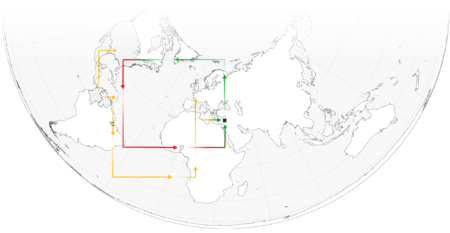Triangular trade in the 21st century

Triangular trade is a multilateral system of trading in which a country pays for its imports from one country by its exports to another. For example, in the later quarter of the 20th century the United States sold infrastructure services and military equipment to Saudi Arabia, which exported oil to Japan, which sold automobiles to the United States. The US ran trade deficits with Japan, while Japan ran a trade deficit with Saudi Arabia, and Saudi Arabia ran a trade deficit with the US. Conversely, the US ran a trade surplus with Saudi Arabia, Saudi Arabia ran a surplus with Japan, and Japan a trade surplus with the United States, thus a global trade balance was achieved.
A bi-polar axis of trade can tend to be one-side, with goods flowing only in one direction, such as the United States experienced with China since 2002. The net result is like an ocean tide, while payment for goods flows into China like a high tide, the United States is drained.[1]
Historically triangular trade was a term used to describe the trans-Atlantic trade route that had three parts or "sides" to the "triangle": Africa to the Americas to transport slaves, the Americas to Europe to transport raw materials, and Europe to Africa to trade finished goods for the purchase of slaves. It was developed by the Portuguese in the 16th century, but later used by Britain, France, Holland, Colonial America and the other maritime nations of Europe.
In the Obama era, cocaine was smuggled into the United States from Latin America, stored in the trunks of used cars that were shipped to Africa, and from Africa the cocaine was smuggled into Europe where it brought a higher price than in Africa. After profit taking, cash then was recycled to the United States for the purchase of more used cars and cocaine.
See also
Further reading
- Ostrander, Gilman M. "The Making of the Triangular Trade Myth", William and Mary Quarterly, 30 (1973), 635-44. in JSTOR